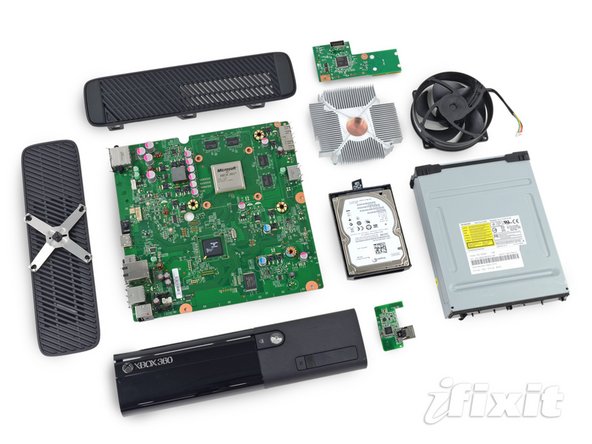The teardown marathon continues! Now available in full HD exhaustion. (Seriously, the wallpaper is starting to dance. WE DON’T EVEN HAVE WALLPAPER.)
During E3, Microsoft briefly announced a redesigned version of the Xbox 360. The brand new(ish) Xbox 360 E is designed to resemble the much-anticipated Xbox One. As the Xbox 360 line is nearing its end, we figured that this new release probably wouldn’t presage any dramatic hardware transformations. But we were curious if the Xbox’s new looks would affect its repairability. So, we handed the device over to our teardown monkeys for disassembly.
They found a couple of notable changes: The Xbox 360 E got a whole-new button board, freeing the RF module from housing the glowing power switch. Also new with this revision, one fewer USB port! The rest of the modifications to the Xbox 360 are predominantly cosmetic. Good news for DIY repairers and upgraders, though—the new case is a bit easier to open than previous 360 models (a change that we hope carries over to the Xbox One).
Over all, the Xbox 360 E fared very well under our industrious spudgers, earning an 8 out of 10 on our repairability scale.
Teardown Highlights:
• Microsoft did a little bit of housekeeping with the backside of the Xbox 360 E, yielding a neater port layout that does away with the old A/V and S/PDIF ports in favor of a single optical audio out jack.
• A pleasant side effect of the new, subdued design is that the top and bottom panels come off far more easily than on the 360 S. Without the chrome bezels, there are fewer clips to pop and less to break on your way inside.
• The Wi-Fi board is tucked away in the backside of the console, and uses the following ICs:
- Marvell 88W8786U integrated MAC/baseband/RF SoC
- Skyworks 2597L 2.4 GHz power amplifier with power detector
- California Eastern Laboratories μPG2179TB SPDT switch
• It’s time to think inside the box. The prominent ICs found on the frontside of the motherboard:
- GlobalFoundries (joint venture of AMD and ATIC) XCGPU SoC (combination of the Xenon CPU and the Xenos X818337 GPU onto the same die, with eDRAM in the same package)
- Microsoft X850744-004 south bridge
- Hynix HY27US08281A 128 Mb NAND flash
- Samsung K4J10324KG-HC14 1 Gb GDDR3 SDRAM (total of four = 4 Gb = 512 MB)





0 Yorum